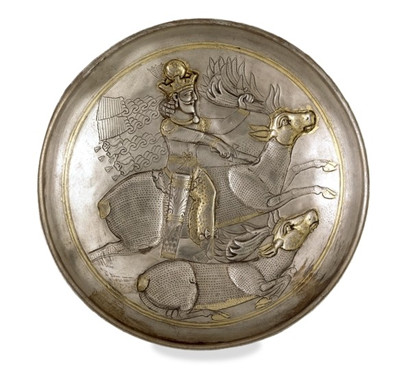In Rome at this time Christianity became the state religion, and almost contemporaneously, in Iran, the Sasanian Dynasty built a highly centralised state, in which secular and religious authority were bound together. At its height, this Iranian empire stretched from the Euphrates to the Indus-in modern terms, from Syria to Pakistan. And for several centuries it was the equal, and the rival, of Rome, in the long struggle to control the Middle East.
當時,基督教剛成為羅馬國教。而在伊朗,薩珊王朝幾乎在同一時期建立起了高度中央集權、政教合一的國家。伊朗帝國的領土從幼發拉底河一直延伸到印度河流域,用現代地理概念來說,便是從敘利亞一直到巴基斯坦。在數個世紀的時間里,它的實力與羅馬相當,是與羅馬爭奪中東控制權的強有力的對手。
The Sasanian king out hunting on this programme's silver dish is Shapur II, who ruled with resounding success for 70 years, from 309 to 379. It's a shallow silver dish, I suppose it's about the size and the shape of a small Frisbee, but it's made of very high quality silver, and as you move it around you can see that it's got highlights in gold. The King sits confidently astride his mount, and on his head he wears a very large crown, with what looks like a winged globe on the top of it. Behind him, ribbons flutter over the silver, giving an impression of movement. Everything about his dress is rich-pendant earrings, long-sleeved tunic with carefully embroidered shoulder pads, highly decorated trousers and ribboned shoes. What we're looking at is an elaborate, carefully worked out ceremonial image of wealth and power.
銀盤上狩獵的薩珊國王是沙普爾二世, 他在位時間為公元309年至公元379年,他成功地統治伊朗長達70年之久。這是一個淺底銀盤,大小與形狀都類似小號飛盤。它用上好的白銀制成,一經轉動還會發現它曾用黃金點綴。國王鎮定地跨坐在坐騎上,頭頂巨大的王冠,冠頂的裝飾就像一個帶翅膀的地球儀,綬帶飄揚在身后,表現出動感。他的衣飾極為奢華:垂墜的長耳環,帶精美墊肩的長袖束 腰外衣,裝飾華美的長褲以及帶緞帶的鞋子。一副精心塑造的表現財富與權力的儀式性形象。












